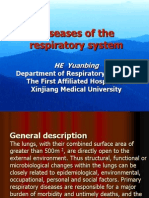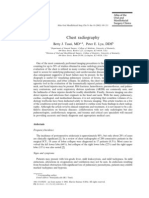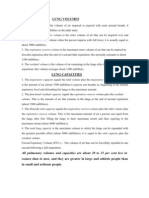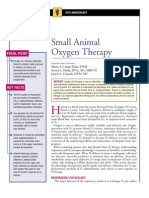Jurnal 2
Jurnal 2
Uploaded by
Seftiana SaftariCopyright:
Available Formats
Jurnal 2
Jurnal 2
Uploaded by
Seftiana SaftariOriginal Title
Copyright
Available Formats
Share this document
Did you find this document useful?
Is this content inappropriate?
Copyright:
Available Formats
Jurnal 2
Jurnal 2
Uploaded by
Seftiana SaftariCopyright:
Available Formats
123
5-76
Calcified Bronchocele
F HAQUE, SZ ABBAS, H PANDEY, HSP BABU, S WAHAB
Ind J Radiol Imag 2006 16:1:123-125
Keywords: congenital, bronchi, computed tomography
INTRODUCTION:
Congenital bronchial atresia, a rather uncommon
congenital anomaly, consists of atresia or stenosis of a
lobar, segmental or subsegmental bronchus at or near
its origin with normal development of distal structures.
Distal to the stenosis the bronchi may become filled with
mucus to form a bronchocele. The contents of the dilated
bronchus may vary from mucoid contents to inspissated
material or very rarely the contents may get calcified.
Chest roentgenograms, spiral CT and MRI features of
congenital bronchial atresia with or without bronchocele
have been described though at present, spiral CT is
accepted as the most sensitive investigation in making
the diagnosis. To the best of our knowledge very few reports
of calcified bronchocele associated with congenital
bronchial atresia have been described.
We report a case of calcified bronchocele associated with
congenital bronchial atresia.
CASE REPORT:
An asymptomatic 28 year old male was referred for the
evaluation of a branching, tubular opacity in the right
l ower l ung fi el d, detected on a routi ne chest
roentgenogram. The patient denied any specific respiratory
symptoms and there was no other relevant medical or
surgical history. The patient was a nonsmoker. The
physical examination was unremarkable. Routine blood
and urine examinations were normal.
Evaluation of the chest roentgenogram revealed tubular,
branching opacities in the right lower lung field surrounded
by an area of hyperlucency. Computed Tomography (CT)
scan was performed which revealed homogenous, tubular
l obul ated branchi ng opaci ti es, surrounded by
hyperinflated, oligemic lung parenchyma in the right lower
lung lobe. The CT absorption coefficients of the lesion
ranged between 450&500HU and the opacities did not
show any enhancement following intravenous contrast
administration. There was no contralateral mediastinal
shift or significant collapse of adjacent lobes. Fibreoptic
bronchoscopy was performed which confirmed the
diagnosis of bronchial atresia .
Fig 1 : a,b Chest radiograph (PA & lateral view) showing
tubular branching opacity in Rt lower lung field.
DISCUSSION:
Congenital bronchial atresia is seen most commonly in
young, adul t mal es.50% of these pati ents are
From the Deptt. of Radiodiagnosis, JNMC, Aligarh
Request for Reprints: Dr. Faisal Haque, 41, Alig Appartments, Shamshad Market, Aligarh - 202002
Received 28 April 2005 ; Accepted 25 February 2006
[Downloadedfreefromhttp://www.ijri.orgonSunday,December09,2012,IP:114.79.16.14]||ClickheretodownloadfreeAndroidapplicationforthisjournal
124
124 F Haque et al IJRI, 16:1, February 2006
asymptomatic. The abnormality is usually discovered on
a routine chest roentgenogram (1,2). Symptomatic
patients may present with recurrent pneumonia,
dyspnoea, cough, hemoptysis or rarely as neonatal
respiratory distress. A localized area of reduced breath
sounds is the most common finding in most patients
reported in the literature (1) and wheezing is heard in
patients with a history of asthma. The diagnosis is
suspected by the radiographic finding of a juxtahilar mass
surrounded by regional hypertranslucency (3). Additional
radiographic features may include mucus filled bronchi
(bronchocele) and branching opacities radiating from the
hilum. Air trapping around the affected area that cannot
be eliminated during expiration probably due to a check
valve mechanism, results in an obstructive segmental or
lobar emphysema. A CT scan confirms the above finding
and is currently the most sensitive test available for
demonstrating the features of congenital bronchial atresia
and to rule out the presence of an obstructing
endobronchial lesion (4). Spiral CT with multiplanar
volumetric reconstruction is helpful in distinguishing a
mucocele from vascular malformation (4). Other imaging
techniques including bronchography and MRI, are either
difficult to interpret or unable to define the regional
hypertranslucency around the bronchocele that is well
visualized by CT scan. Thoracic MRI when performed,
reveals the bronchocele as a branching opacity displaying
hyperintensity on both T1 Weighted and T2 Weighted
images due to the high level of protein content. The
impacted mucus in bronchoceles may get calcified (5)
and then these lesions are depicted as signal voids on
both T1W and T2W images(6). Arteriography is used to
exclude the presence of pulmonary sequestration,if
suspected.
Spiral CT is the examination of choice, not only to show
all the components of the anomaly and to estimate the
extent of air trapping but also for ruling out differential
diagnosis such as bronchogenic cyst, bronchiectasis,
aspergillosis, completely thrombosed arteriovenous
malformation or pulmonary aneurysms and tumors.
The frequency of bronchial involvement is in the following
order: left upper lobe 64%, left lower lobe 14% and right
lower and middle lobes in only 8%(2).
Development of bronchial buds occurs between the 4th
and 15th weeks of gestation (7). A vascular insult during
this period may cause interruption of the process, resulting
in fibrosis and atresia of the involved segment. The normal
appearance of the lung parenchyma distal to the atretic
segment is supportive of a late development of the atresia
after bronchial development is completed. The high
frequency of involvement of the left upper lobe supports
the ischemic theory, since the left upper lobe is the area
of embryonic instability that develops late in utero. Beside
congenital bronchial atresia, bronchoceles are seen in
cases of acquired bronchial obstruction secondary to
allergic bronchopulmonary aspergillosis, malignant tumors
and tuberculous bronchostenosis and can be confused
with tuberculomas, hydatid cysts and solitary pulmonary
nodules. However, distal hyperinflation is seen only in
bronchial atresia, intralobar pulmonary sequestration and
bronchogeni c cysts(8). Radi ography, CT and
bronchoscopy usually help make the distinction among
these differentials.
Fi g 2 : a,b (Medi asti nal and l ung wi ndow) showi ng
homogenous lobulated tubular branching opacity surrounded
by regional hypertranslucent,oligemic area.
Pathologic findings in patients who underwent resection,
revealed that the left upper lobe was the most common
location. Grossly the involved segment or lobe is markedly
emphysematous and free of anthracotic pigment because
of the relative lack of regional ventilation. Cystic dilatation
of the atreti c bronchus i s di sti ngui shed from
bronchiectasis by the presence of normally branching and
distally extending bronchi. The involved parenchyma
shows alveolar hypoplasia, a probable consequence of
decreased ventilation and perfusion. These alveoli however
remain open by collateral air drift occurring by the
interalveolar pores of Kohn (air drift) or the bronchoalveolar
channels of Lambert or the interbronchiolar channels (1).
In conclusion,spiral CT scan appears to be the imaging
[Downloadedfreefromhttp://www.ijri.orgonSunday,December09,2012,IP:114.79.16.14]||ClickheretodownloadfreeAndroidapplicationforthisjournal
125
IJRI, 16:1, February 2006
modality of choice to evaluate and diagnose patients with
congeni tal bronchi al atresi a and bronchocel e.
Asymptomatic patients may be, managed conservatively
while patients presenting with complications like recurrent
pneumonia are preferably treated surgically.
REFERENCES:
1. Jederl i ni c PJ,Si ci l i an L,Bai gel man W,et
al(1986)Congenital bronchial atresia:a report of four
cases and a review of literature.Medicine;65:73-83.
2. Ward S,Morcos SK(1999)Congeni tal bronchi al
atresia:presentation of three cases and a pictorial
revieqw.Clin Radiol;54:144-148.
3. Tal ner LB,Gmel i ch JT,Li ebow AA,et al (1970)The
syndrome of bronchi al mucocel e and regi onal
hyperinflation of the lung.Am J Roentgenol;110:675-686.
4. Beigelman C,Howarth NR,Chartrand-Lefebvre C,et
Calcified Bronchocele 125
al(1998)Congenital anomalies of tracheobronchial
branching pattern:spiral CT aspects in adults.Eur
Radiol;8:79-85.
5. Stuart S Sagel and Richard M.Slone,Lung(chapter
7,Fig.95).In Joseph KT Lee,Stuart S Sagel,Robert J
Stanley,et al(1998)Computed Tomography with MRI
correl ati on,3rd Edi ti on,Vol umeI,Li ppi ncot-Raven
Publishers,Philadelphia:405.
6. William R.Nemzik,Regina Gandour-Edwards et al-The
Nasal Cavity and Paranasal Sinuses,Chapter 31,Volume
I I , 1 0 8 2 - 1 0 8 4 . I n . N e u r o i m a g i n g -
Wi l l i a mW. Or r i s o n ( 2 0 0 0 ) , W. B . S a u n d e r s
Company,Philadelphia.
7. Genereux GP(1970)Bronchial atresia.A rare cause of
uni l ateral l ung hypertransl ucency.J Can Assoc
Radiol;21:71-82.
8. Fel son B(1979)Mucoi d i mpacti on(i nspi ssated
secreti ons)i n segmental bronchi al
obstruction.Radiology;133:9-16.
[Downloadedfreefromhttp://www.ijri.orgonSunday,December09,2012,IP:114.79.16.14]||ClickheretodownloadfreeAndroidapplicationforthisjournal
You might also like
- Energy Producing & Distributing SystemsDocument40 pagesEnergy Producing & Distributing SystemsZerille Anne InsonNo ratings yet
- Lung Lobe Torsion in 15 Dogs - Peripheral Band Sign On UltrasoundDocument10 pagesLung Lobe Torsion in 15 Dogs - Peripheral Band Sign On UltrasoundAdan Camilo Ramirez CarranzaNo ratings yet
- The V-Line: A Sonographic Aid For The Confirmation of Pleural FluidDocument4 pagesThe V-Line: A Sonographic Aid For The Confirmation of Pleural FluidAlpi ApriansahNo ratings yet
- Asthma and Lung MassDocument4 pagesAsthma and Lung MassAzmachamberAzmacareNo ratings yet
- Journal Radiologi 3Document14 pagesJournal Radiologi 3WinayNayNo ratings yet
- Neu Motor AxDocument6 pagesNeu Motor AxZay SiagNo ratings yet
- Postmedj00157 0004Document15 pagesPostmedj00157 0004mcramosreyNo ratings yet
- Interstitial Lung DiseaseDocument4 pagesInterstitial Lung DiseasedewimarisNo ratings yet
- Esti2012 E-0066Document40 pagesEsti2012 E-0066nistor97No ratings yet
- A Case of Tracheal Tumor Masquerading As AsthmaDocument4 pagesA Case of Tracheal Tumor Masquerading As Asthmamastansk84No ratings yet
- Bronquiolite DiagnosticoDocument14 pagesBronquiolite DiagnosticoFrederico PóvoaNo ratings yet
- PDF To WordDocument17 pagesPDF To Wordanisa ghinaNo ratings yet
- Chronic Obstructive Pulmonary Disease: Radiology-Pathology CorrelationDocument10 pagesChronic Obstructive Pulmonary Disease: Radiology-Pathology CorrelationNetii FarhatiNo ratings yet
- Case Report: Pulmonary Sequestration: A Case Report and Literature ReviewDocument4 pagesCase Report: Pulmonary Sequestration: A Case Report and Literature Reviewjo_jo_maniaNo ratings yet
- Sonographic Diagnosis of Pneumonia and BronchopneumoniaDocument8 pagesSonographic Diagnosis of Pneumonia and BronchopneumoniaCaitlynNo ratings yet
- Interpretando RX PediatricoDocument10 pagesInterpretando RX PediatricosuzukishareNo ratings yet
- Rednic 2010 Pictorial Essay Subpleural TumorsDocument7 pagesRednic 2010 Pictorial Essay Subpleural Tumorsmarvic gabitanNo ratings yet
- SGL6 - CoughDocument63 pagesSGL6 - CoughDarawan MirzaNo ratings yet
- Atotw 523 PocusDocument15 pagesAtotw 523 PocusIngrid AraújoNo ratings yet
- Trapped Lung - StatPearls - NCBI BookshelfDocument7 pagesTrapped Lung - StatPearls - NCBI BookshelfVinna KusumawatiNo ratings yet
- Journal of Thoracic ImagingDocument11 pagesJournal of Thoracic Imagingestues2No ratings yet
- Medicine: Lymphangiomatosis Involving The Pulmonary and Extrapulmonary Lymph Nodes and Surrounding Soft TissueDocument5 pagesMedicine: Lymphangiomatosis Involving The Pulmonary and Extrapulmonary Lymph Nodes and Surrounding Soft TissueAngel FloresNo ratings yet
- A Case of Primary Papillary Disseminated Adenocarcinoma of Canine LungDocument5 pagesA Case of Primary Papillary Disseminated Adenocarcinoma of Canine LungStéfano Celis ConsiglieriNo ratings yet
- Diseases of The Respiratory SystemDocument71 pagesDiseases of The Respiratory SystemZafir SharifNo ratings yet
- Chest RadiographyDocument23 pagesChest Radiographyapi-3773951100% (2)
- Thorax 2003 Lordan 814 9Document7 pagesThorax 2003 Lordan 814 9Ari KuncoroNo ratings yet
- Section II - Chest Radiology: Figure 1ADocument35 pagesSection II - Chest Radiology: Figure 1AHaluk Alibazoglu100% (1)
- Bedside Lung Ultrasound Versus Chest X-Ray Use in The Emergency DepartmentDocument3 pagesBedside Lung Ultrasound Versus Chest X-Ray Use in The Emergency DepartmentharnellaNo ratings yet
- New Folder For Ultrasound PaperDocument9 pagesNew Folder For Ultrasound Paperdurga7No ratings yet
- Congenital Lobar EmphysemaDocument3 pagesCongenital Lobar Emphysemamadimadi11No ratings yet
- Internal Medicine Department Dr. M. Djamil Hospital, Padang 2017Document21 pagesInternal Medicine Department Dr. M. Djamil Hospital, Padang 2017Gina ArianiNo ratings yet
- Journal Reading PulmonologiDocument21 pagesJournal Reading PulmonologiGina ArianiNo ratings yet
- Ultrasound For "Lung Monitoring" of Ventilated PatientsDocument11 pagesUltrasound For "Lung Monitoring" of Ventilated PatientsCarlos FloresNo ratings yet
- High Resolution CT of The Lungs: Technique, Indications and FindingsDocument9 pagesHigh Resolution CT of The Lungs: Technique, Indications and FindingsHari Baskar SNo ratings yet
- Congenital Lung MalformationsDocument115 pagesCongenital Lung MalformationsAhmad Abu KushNo ratings yet
- 2010 Hemorragia Alveolar DifusaDocument8 pages2010 Hemorragia Alveolar DifusaCecilia Requejo TelloNo ratings yet
- Emphysema ImagingDocument6 pagesEmphysema Imagingestues2No ratings yet
- Lungultrasoundfor Pulmonarycontusions: Samuel A. DickerDocument11 pagesLungultrasoundfor Pulmonarycontusions: Samuel A. DickerCarlosfff1 QueirozNo ratings yet
- Radiological Signs (Shënja Radiologjike) - 1Document122 pagesRadiological Signs (Shënja Radiologjike) - 1Sllavko K. KallfaNo ratings yet
- 15 Signs in Thoracic Imaging.20Document15 pages15 Signs in Thoracic Imaging.20Don Kihot100% (1)
- Corpus Alienum PneumothoraxDocument3 pagesCorpus Alienum PneumothoraxPratita Jati PermatasariNo ratings yet
- Surgical Therapy For Necrotizing Pneumonia and Lung Gangrene PDFDocument6 pagesSurgical Therapy For Necrotizing Pneumonia and Lung Gangrene PDFmichael24kNo ratings yet
- Emphysema Versus Chronic Bronchitis in COPD: Clinical and Radiologic CharacteristicsDocument8 pagesEmphysema Versus Chronic Bronchitis in COPD: Clinical and Radiologic CharacteristicsChairul Nurdin AzaliNo ratings yet
- Radiographic Signs of Pulmonar DiseaseDocument10 pagesRadiographic Signs of Pulmonar DiseaseMarleeng CáceresNo ratings yet
- Nader Kamangar, MD, FACP, FCCP FCCM, FAASM, Associate Professor of Clinical Medicine, UniversityDocument7 pagesNader Kamangar, MD, FACP, FCCP FCCM, FAASM, Associate Professor of Clinical Medicine, UniversitynurulfitriantisahNo ratings yet
- Jurnal RadiologiDocument5 pagesJurnal RadiologiKen FcNo ratings yet
- Lung Cancer in ChildDocument4 pagesLung Cancer in Childtonirian99No ratings yet
- Congenital Asymptomatic Diaphragmatic Hernias in Adults: A Case SeriesDocument8 pagesCongenital Asymptomatic Diaphragmatic Hernias in Adults: A Case SeriesRangga Duo RamadanNo ratings yet
- Sep 1, 2011) Journal: Medscape Radiology: Radiological Society of North AmericaDocument19 pagesSep 1, 2011) Journal: Medscape Radiology: Radiological Society of North AmericaMohamad Rizki DwikaneNo ratings yet
- Pneumotorax Syr06lDocument53 pagesPneumotorax Syr06lflavia_craNo ratings yet
- Ultrasound of Extravascular Lung Water: A New Standard For Pulmonary CongestionDocument8 pagesUltrasound of Extravascular Lung Water: A New Standard For Pulmonary CongestiongcfutureNo ratings yet
- Radiological– Pathological Correlation in DiDocument9 pagesRadiological– Pathological Correlation in DiRaudha Dani RahmalisaNo ratings yet
- HRCTDocument82 pagesHRCTmahmod omerNo ratings yet
- MDCT Evaluation of Foreign Bodies and Liquid Aspiration Pneumonia in AdultsDocument9 pagesMDCT Evaluation of Foreign Bodies and Liquid Aspiration Pneumonia in AdultsHafidz ZuhairNo ratings yet
- Jurnal Radio Inggris TalDocument17 pagesJurnal Radio Inggris TalimamattamamiNo ratings yet
- Lung Ultrasound: A New Tool For The CardiologistDocument9 pagesLung Ultrasound: A New Tool For The CardiologistNag Mallesh RaoNo ratings yet
- Ers Monograph Google Book : Id 7Nnbcwaaqbaj&Pg Pa152&Dq Imaging+Ards&Hl En&Sa X&Redir - Esc Y#V Onepage&Q&F TrueDocument3 pagesErs Monograph Google Book : Id 7Nnbcwaaqbaj&Pg Pa152&Dq Imaging+Ards&Hl En&Sa X&Redir - Esc Y#V Onepage&Q&F TruecindyraraNo ratings yet
- Pulmonary Functional Imaging: Basics and Clinical ApplicationsFrom EverandPulmonary Functional Imaging: Basics and Clinical ApplicationsYoshiharu OhnoNo ratings yet
- Closed Reduction and Percutaneous Kirschner - Wire Fixation OF Displaced Colles Fracture in AdultsDocument10 pagesClosed Reduction and Percutaneous Kirschner - Wire Fixation OF Displaced Colles Fracture in AdultsSeftiana SaftariNo ratings yet
- Is HRCT Reliable in Determining Disease Activity in Pulmonary Tuberculosis?"Document0 pagesIs HRCT Reliable in Determining Disease Activity in Pulmonary Tuberculosis?"Seftiana SaftariNo ratings yet
- 998.full ReferatDocument12 pages998.full ReferatSeftiana SaftariNo ratings yet
- 998.full ReferatDocument12 pages998.full ReferatSeftiana SaftariNo ratings yet
- CLASS 10th RESPIRATIONDocument3 pagesCLASS 10th RESPIRATIONNavkaran SinghNo ratings yet
- ArdsDocument29 pagesArdsAmani KayedNo ratings yet
- Anatomy and Physiology of Respiratory System Relevant To AnaesthesiaDocument10 pagesAnatomy and Physiology of Respiratory System Relevant To AnaesthesiaAnonymous h0DxuJTNo ratings yet
- Inhalational AnesthesiaDocument96 pagesInhalational AnesthesiaNachee PatricioNo ratings yet
- Anes Airway-IntubationDocument12 pagesAnes Airway-IntubationSGD5Christine MendozaNo ratings yet
- Ealth AND Hysical Ducation: A Teachers' Guide For Class VIDocument176 pagesEalth AND Hysical Ducation: A Teachers' Guide For Class VIManoj AryanNo ratings yet
- Kundalini Activation Using PranayamaDocument21 pagesKundalini Activation Using PranayamaStephen SequeiraNo ratings yet
- Lung VolumesDocument1 pageLung VolumesGeorge ZachariahNo ratings yet
- Ventilator-Associated Pneumonia - Risk Factors & Prevention (Beth Augustyn)Document8 pagesVentilator-Associated Pneumonia - Risk Factors & Prevention (Beth Augustyn)ariepitonoNo ratings yet
- Fabian VentilatorDocument17 pagesFabian VentilatorRohana AnaNo ratings yet
- 5ОМ англ ВОП 1Document22 pages5ОМ англ ВОП 1p69b24hy8pNo ratings yet
- ATELEKTASISDocument37 pagesATELEKTASISGalih Arief Harimurti WawolumajaNo ratings yet
- Airway BlocksDocument5 pagesAirway BlocksvineeshNo ratings yet
- VoiceDocument6 pagesVoiceOmar AcNo ratings yet
- LelcDocument11 pagesLelcSho TiNo ratings yet
- ANATOMY PHYSIOLOGY BSC PAPER 1ST SEM (1)Document3 pagesANATOMY PHYSIOLOGY BSC PAPER 1ST SEM (1)Desai AasthaNo ratings yet
- Common ColdDocument3 pagesCommon Coldanisa rimadhaniNo ratings yet
- Lesson 2 Chest Physiotherapy Incentive Spirometry Chest DrainageDocument14 pagesLesson 2 Chest Physiotherapy Incentive Spirometry Chest DrainageRENEROSE TORRESNo ratings yet
- DG MFA EXIT EXAM QUESTIONS AND ANSWERS 3.0 - Part CDocument6 pagesDG MFA EXIT EXAM QUESTIONS AND ANSWERS 3.0 - Part CDiptendu ParamanickNo ratings yet
- Jism Al InsaanDocument26 pagesJism Al InsaantisuchiNo ratings yet
- NCP!!!!Document2 pagesNCP!!!!April Grace LopezNo ratings yet
- Assignment On TRACHEOSTOMYDocument12 pagesAssignment On TRACHEOSTOMYPrasann Roy100% (2)
- Chest Physiotherapy 2019Document53 pagesChest Physiotherapy 2019Jing BMNo ratings yet
- 01 Airway Management and ProceduresDocument18 pages01 Airway Management and ProceduresChing BanagNo ratings yet
- Hemodynamic Effects of Positive End Expiratory.142Document10 pagesHemodynamic Effects of Positive End Expiratory.142NEUMOLOGIA TLAHUACNo ratings yet
- Small Animal Oxygen TherapyDocument10 pagesSmall Animal Oxygen Therapytaner_soysuren100% (1)
- Vital Signs NCM 100 Skills Laboratory - EditedDocument175 pagesVital Signs NCM 100 Skills Laboratory - EditedrnrmmanphdNo ratings yet
- Nursing Care of The NewbornDocument56 pagesNursing Care of The NewbornAngie Zimmerman DreilingNo ratings yet
- Introduction To SplanchnologyDocument2 pagesIntroduction To SplanchnologyMohit BhardwajNo ratings yet




























































































